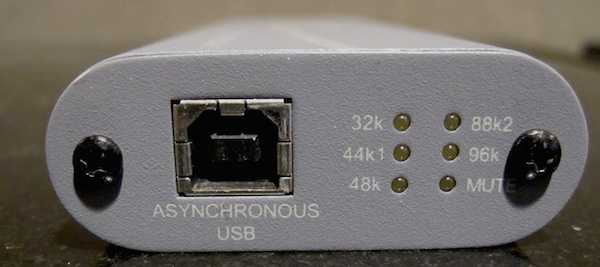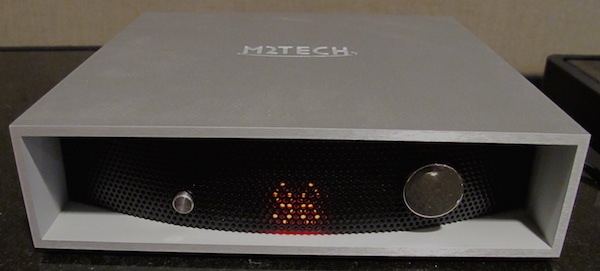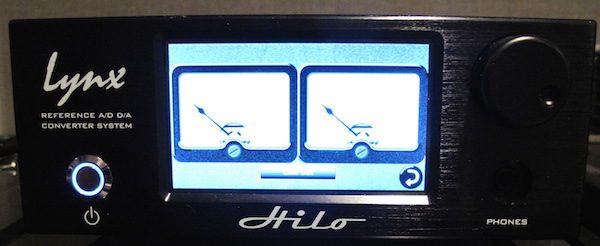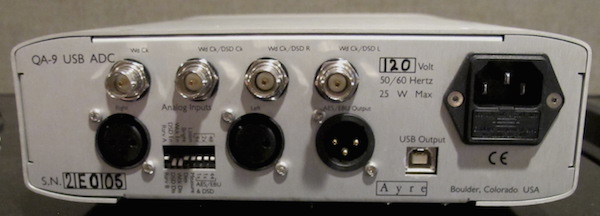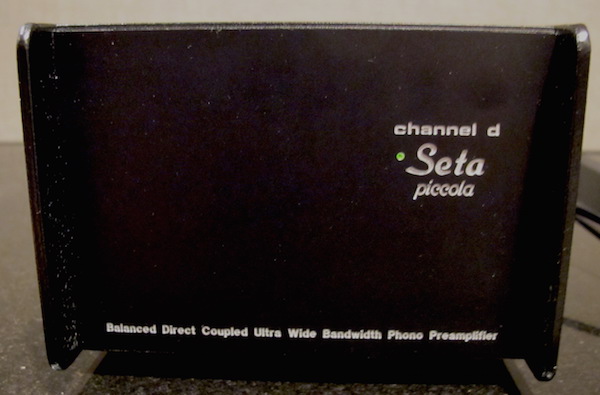Analog To Digital Converter Files Identified, Converters Profiled
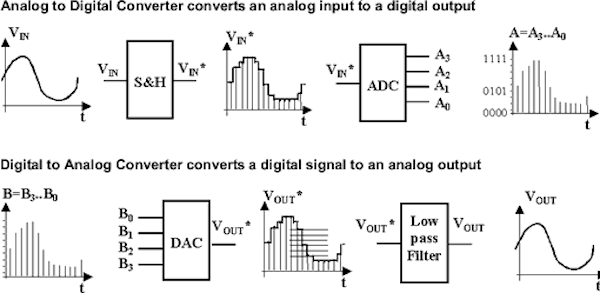
The HRT Linestreamer+
The HRT Linestreamer+ is a basic, asynchronous A/D converter. It features a pair of line level RCA input jacks on one side of its enclosure and a USB digital output jack on the other. The 24 bit digital converter chipset supports sampling rates of 32kHz, 44.1kHz, 48kHz, 88.2kHz and 96kHz.
Full scale sensitivity is 2.25 volts RMS.
Input impedance is 5Kohms.
Claimed frequency response is 20Hz-20kHz (+0/-.4dB).
S/N ratio (DC-30kHz) is 104dB (A-weighted: 109dB).
THD+N (total harmonic distortion+noise) (1kHz Full Scale): .003%. THD+N (1kHz-20dB): .001%.
Jitter Contribution (DC to 30kHz): >130dB below full scale.
Power requirements (USB Buss): 450mA.
Dimensions: 2.9”x2.4”x5.8”.
Made in U.S.A.
Price: $349.95 (subject to discounts).
The HRT Linestreamer+ is the least expensive A/D converter in this group. It is the simplest to use. Just plug a line level analog output into its pair of RCA jacks and connect a USB cable to your computer. The USB Buss powers it. You use the native Audio Class 1 drivers present in all modern PC, Mac and Linux based computers along with you choice of recording software (Pure Vinyl, Vinyl Studio, etc.).
LEDs on one side indicate the selected sampling rate and a pair of peak indicators on the other alert you to overload levels.
Of course, if your phono preamp lacks gain adjustability (most don’t) and you’re connecting via a preamp “tape out” and the LEDs light, you are out of luck. In that case your only choice would be to use a lower output phono cartridge. However, under most circumstances that should ot be a problem.
Most of the samples here were recorded using Vinyl Studio primarily because it’s more convenient to use than Pure Vinyl when recording short excerpts.
The HRT Linestreamer+ is File #5.
The M2TECH Joplin 384kHz/32 bit Analog-to-Digital Converter
The $2499 M2TECH Joplin is a stylish-looking A/D converter, not surprising given its Italian origins. It’s also among the most versatile, in that it also includes a built-in MM phono preamplifier with multiple EQ curves. It’s less useful if you use a low output MC cartridge. The instructions say you can use a low output MC as low as 0.5mV but at the cost of a slight dynamic loss.
However, you could insert an outboard step-up transformer in the signal path to take advantage of the built-in phono preamp feature.
For the purposes of this survey we used it only as an A/D converter but among the built-in curves are those for Angel, Capitol, Columbia, HMV, Decca/London FFRR, Pacific Jazz, some 78rpm curves and tape EQ curves. If you are a collector of pre-stereo LPs particularly jazz, that you wish to digitize the M2TECH is worthy of your attention.
It is superbly built inside and out and includes a remote control. Set-up is relatively straightforward. The back panel includes RCA analog inputs, AES/EBU and S/PDIF out and in, Toslink out and of course a USB 2.0 port.
It is an asynchronous device and MAC, Linux and Windows compatible. With a Mac it’s “plug and play”. Windows users need to install drivers from the company’s website.
The versatile Joplin allows you to set input gain (0dB, or between 10dB and 65dB in 1dB steps with 0dB meaning an input voltage of 1.7Vrms produces 0dBFS or full dynamic range), input choice (analog or coaxial digital), sampling frequency (44.1kHz, 48, 88.2, 96,176.4, 192, 352.8 and 384kHz. Of course since the unit is asynchronous, the actual sampling rate chosen once you set it on the unit itself will be set not by the Joplin, but by the computer once it’s connected.
The Joplin’s native resolution is 32 bits. When lower resolution is chosen the unit automatically “tosses bits”, which leads to distortion so dither can be applied, which turns the distortion into more ear-pleasing white noise (32 bits is available only via the USB output). High and low pass filters are also options. Finally, the Joplin comes standard with a 15V/1A “wall-wart” type power supply. M2TECH also makes available a high-quality battery-powered power supply called the “Palmer Power Station”, which was not supplied for this review.
The Joplin can be controlled from the front panel or from a small plastic remote supplied. The ergonomics as well as the instruction manual are excellent. Especially welcome was that the instructions do not suggest that curves other than RIAA were used in the stereo era because they were not, despite claims by some to the contrary. However, while the curved mesh front panel adds visual appeal it also makes difficult reading the LED display. It’s a minor annoyance.
A few specs:
THD+N: 0.0004% (1kHz@0dBFS, fs=192kHz, 0-20kHz)
S/N ratio: 122dB (A-weighted, fs=384kHz)
The Joplin is an impressive piece of gear with a wide range of capabilities. Certainly, if your goal is to digitize 78s or older mono LPs, or tape that should be specifically equalized, the Joplin is worth considering. It has other functionality as well but for the purposes on this survey, we chose to concentrate on its sound quality digitizing “flat” using an outboard phono preamplifier that provides both the gain and RIAA equalization.
Files 2 and 3 were made using the M2TECH Joplin. For File 2 the Joplin was set to its native 32 bit resolution, while for file 3 it was set to 24 bit, matching the resolution of the other files. However, the 32 bit file produced appears to be 24 bit resolution (though the two files don’t sound identical).
The Lynx Hilo A/D and D/A Converter
The Lynx Studio Technology Hilo incorporates both A/D and D/A conversion in a single chassis. It is a true “pro-audio” piece manufactured by a company long known for pro audio gear, both outboard and on computer cards.
The Hilo costs $2495 but can often be had at a “street price” of $2,295. Its versatility in terms of A/D and D/A conversion sets it apart from the other units profiled here. However, because it is designed for both pro and home use, it can be somewhat tricky to set up and use until you fully understand its functionality and multi-screen operating system. It can even be battery powered and used in the field and can be had with either USB and “Thunderbolt” connectivity (for use with MacIntosh computers). The review sample was provided with a Thunderbolt connection.
If you are interested in learning all of what this unit can do, please download the user manual. The hyperlink will take you to the Thunderbolt manual but you can easily find the USB one. There is definitely a learning curve involved with using the Hilo but once it’s properly configured, as long as you don’t push the wrong screen buttons, using it is relatively straightforward.
The “meters” in the picture are “virtual”. You can also set the screen to show bar meters instead. The Hilo includes a headphone jack for monitoring as well as a wide range of functionality not likely to be used by home enthusiasts but considering the reasonable price, it’s not as if you are paying extra for the unused functionality.
The Hilo is not compatible with Windows 95, 98, ME, or Windows 2000. Mac compatibility is limited to newer Intel processor equipped Macs running OS X 10.6.4 or higher.
The balanced design features only XLR connectors but XLR/RCA adapters work fine. Hilo offers 24 bit 44.1kHz,48, 88.2, 96, 176.4 and 192K sampling rates. Push button “line trim” allows analog domain input level adjustability. The Hilo has a 32x32 channel mixer among its many features. It can also play back DSD audio files via USM, AES-3 or S/PDIF via DoP V1.1 standard, which transfers DSD audio over PCM frames, supported by Channel D (Pure Vinyl, Pure Music), Audirvana and JRiver Media Player for Windows.
For the purposes of this survey all recording was done in PCM. The Hilo was used twice in this survey: once as a standard A/D converter. That would be File #4
The PS Audio NuWave Phono Converter
The PS Audio NuWave Phono Converter used here is an updated version of the model reviewed here last year as a phono preamplifier only. Please read that review for more details. The original NuWave reviewed and “blind tested” by analogplanet readers did not fare well, with readers or the reviewer. A second sample was far better. This revised edition will get soon another listen and be re-reviewed as a phono preamp.
Like the M2TECH Joplin, the NuWave has both a built in phono preamplifier and an asynchronous A/D converter. It can convert to both PCM at all standard sampling rates from 44.1k to 192kHz and at 16, 18, 20 and 24 bit resolution. In DSD mode it can sample standard 2.8MHz or double (5.6MHz). Like the Hilo it uses DoPv1.1 to send DSD over PCM .It features an 12S buss via an HDMI port for both PCM and DSD as well as a USB “B” port for both PCM and DSD transfers. Considering all of its functionality as both a phono preamp (MM/MC) and an A/D converter, and its high build quality, its $1.899 price makes it a relative bargain. You can get more details here.
. File #6 was created using the PS Audio NuWave Phono Converter.
The Ayre AQ-9 Analog to Digital Converter
The Ayre QA-9 is available in two versions: “standard” and “Pro”. The standard version includes USB and AES/EBU digital outputs. The “Pro” version adds both DSD and word clock outputs for use in studios and for those who prefer DSD to PCM. For a full review, please read Stereophile editor John Atkinson’s full review. There you can read the full functionality and specs.
Here’s an interesting excerpt:
"The heart of the QA-9 is the AT1201, a two-channel A/D converter chip that is new to me, from a company also new to me: Arda Technologies. The chip's datasheet describes it as an "advanced multi-bit sigma-delta" converter that will operate up to a sample rate of 384kHz with an astounding dynamic range of 124dB."
(Ayre’s Charlie Hansen explained) "Arda does consulting work for big contractors. They are audiophiles, and in their spare time designed and built a new A/D chip that clearly outperforms anything from the competition. Specifically, the out-of-band noise is ridiculously low, and this gave us a lot of freedom to 'think different' (as Apple ungrammatically said a couple of decades ago)."
The Ayre-QA-9 has front panel analog input metering and a front mounted analog trim control that makes easy preventing overload and digital clipping.
File #7 was created using the Ayre QA-9. Now here’s where it gets a bit crazy. As many of you noted, the channels were reversed on the original posted file. That was due to a firmware glitch that I thought was corrected by a chip replacement sent by Ayre. Obviously it was not. I then flipped the channels and re-recorded the tracks. Yet when it was posted, it too has the channels swapped. I cannot explain this.
The Channel D Seta® PIccola Balanced Direct-Coupled Ultra-Wide Bandwidth Phono Preamplifer
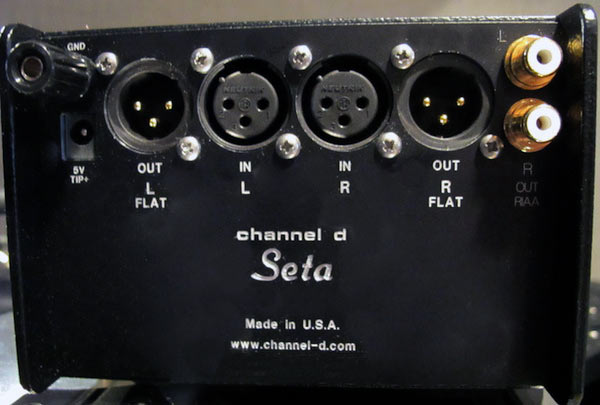
The Channel D Seta PIccola ($1899) is a battery powered fully balanced phono preamplifier that offers both RIAA equalized and “flat” outputs, the latter for use with its Pure Vinyl software that can perform in the digital domain RIAA and a wide range of other EQ options. It also incorporates an RIAA equalized output for use as a standard phono preamplifier. Build quality is very high. The unit sent for review featured RCA jacks for the RIAA output that were too close together to be used with “fat cables” but a revised version fixes that. (We will soon review the Seta as an RIAA phono preamp). You can read about both Channel D phono preamplifiers here.
For this comparison, we ran the phono leads directly into the Piccola and its balanced outputs into the Lynx Hilo per the recommendation of the Piccola designer who also wrote the Pure Vinyl software. So for this file, the recording was done “flat” at 192/24 and then the software rendered a 96k/24 bit file with applied digital domain RIAA.
This was File #1.
Again, why the channels were reversed remains a mystery, but here it may very well have been “operator error” and for that we apologize.
To Sum It All Up
File #1 was the Channel D Seta, Pure Vinyl Sofware, Lynx Hilo.
File #2 was the M2TECH Joplin 32 bit
File #3 was the M2TECH Joplin 24 bit
File #4 was the Lynx Hilo
File #5 was the HRT Linestreamer+
File #6 was the PS Audio NuWave Phono Converter
File #7 was the Ayre QA-9
As of today, March 23, 2015, the voting results are as follows:
29% thought the files all sounded identical
15% preferred File #1 (Seta/Pure Vinyl/Lynx)
15% preferred File #2 (M2TECH 32)
11% preferred File #5 (HRT Linestreamer+)
11% preferred File #7 (Ayre QA-9)
9% preferred File # 3 (M2TECH 24)
5% preferred File #4 (Lynx Hilo)
5% preferred File #6 (PS Audio NuWave)
Based on these results we can say that for the 29% who thought they all sounded alike, their best bet would be to buy the $399 HRT Linestreamer+ as long as they understand that they will have no control over overloading the input other than by somehow reducing gain by changing to a lower output cartridge or phono preamplifier.
As for the rest of the results, you can draw your own conclusions and in doing so please consider the prices.
The Editor’s Observations
Here are excerpts from my listening notes. Yes, you can claim “conformational bias” because I knew what I was listening to, but still, I was greatly surprised by some of the results:
File # 1: I was expecting this to be among my favorites but it was not. I found the sound “relatively icy, spatially flat relative to other files, with an overly sharp attack, and less than generous sustain and decay.” Keep in mind that unlike all of the other files that were produced using a $27,000 LCR vacuum tube equipped phono preamp and a $6000 step up transformer, this file used a $3700 solid state phono preamp and that probably accounted for a great deal of the sonic differences between it and the rest.
File #2: Was a sonic relief moving from File #1. The xylophone was richer and more “bell-toned”. There was noticeably greater ambience around the instruments and overall spaciousness. I noted “more air around snare drum” as well as greater bass extension to tympani and more “skin”.
File #3: sounded very similar to 2 but I thought there was even more delicacy, with the wood block sounding more “woody” and the xylophone having more air and placed further back in space. “Greater delicacy to the bell attack”.
File #4: drier and more like File 1 but more open and less brittle. Wood block not as ‘woody’ and xylophone less bell-toned. Snare drum not as crisp. Sustain moderately generous, decay not as generous either. Tympani not as fully extended. But overall, pretty good. So far 3 is favorite followed by 2 then 4 and 1 is last.
File #5: Easy on the ears but due to softening of transients and a softer, slower attack. Tympani not as deep or explosive. Xylophone drier and less expressive. Moderately good depth. Snare softer. Low level detail behind snare almost missing in action. Got hard when everything going. Less delineation to snare. Xylophone runs before crescendo notably soft.
File #6: Sounded similar to file 5. Somewhat muted and soft. Tympani not as deep or well defined. Bells softer. Snare lacked full “crack”. Stage flattened. Confused and hard near the end. Xylophone run before crescendo softened and lost note detail.
File #7: channels reversed again! More like file 3. Precise attack with wood sounding like wood, tympani well expressed. Bells sound like bells. Xylophone sounds rich yet precise. Good shimmer, generous sustain and decay produces good soundstage depth. Overall best in instrument 3 dimensionality.
Conclusion
The system used was the Continuum Caliburn, Cobra arm, Lyra Atlas cartridge, Ypsilon VPS-100 phono preamp with MC-10L step transformer, except for the Seta Piccola/Pure Vinyl version, which bypassed the Ypsilon gear and went directly into the Lynx.
I really tried not to consider what was what when making these observations. My sonic favorites were the M2TECH and the Ayre QA-9. I thought they sounded the most “analog-y”. I found the Hilo a bit drier and less effortless than either the M2TECH or the Ayre. That was disappointing because I really like the Hilo’s functionality and was considering buying it.
Please consider the price differential between the Ypsilon phono preamp and the Seta Piccola when comparing those files!
If all you want to do is casually rip your vinyl, the $399 HRT LInestreamer is all you’ll need. If you’re archiving, you should consider something more sophisticated. For that I really do like the Pure Vinyl system.
For those reading and saying “Stop nit picking and just enjoy the music”, I hear you! Just doing my job.
